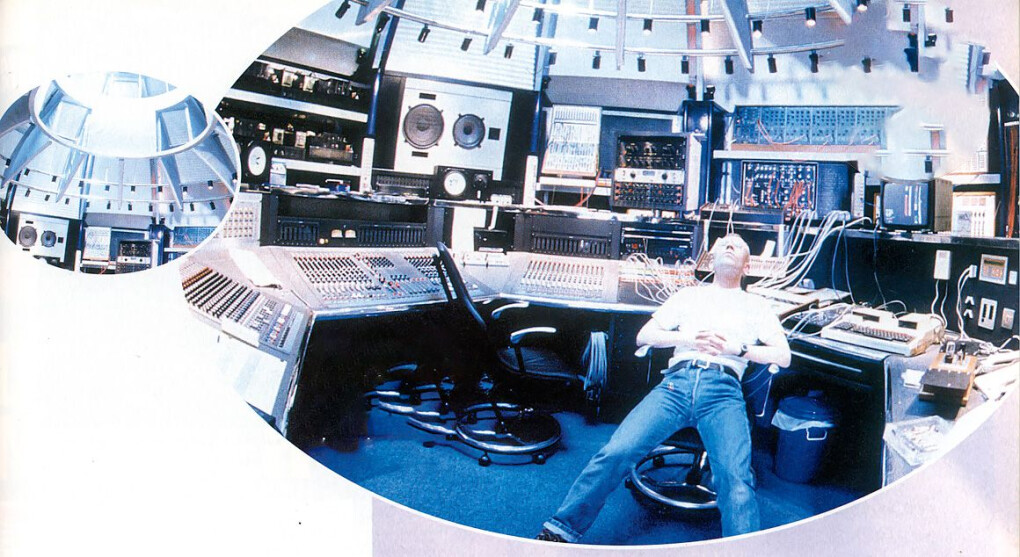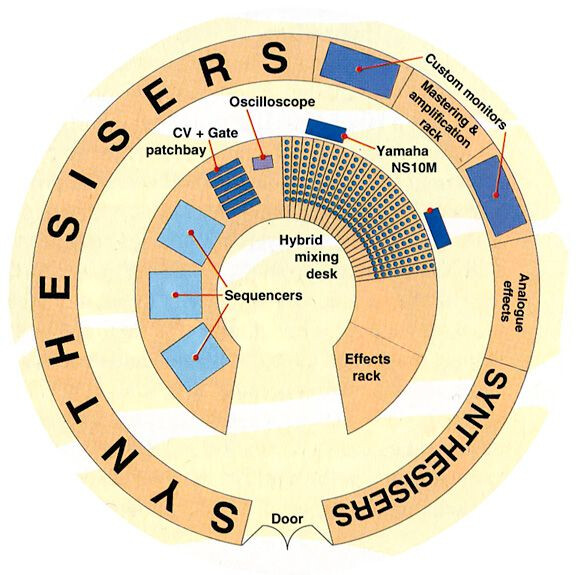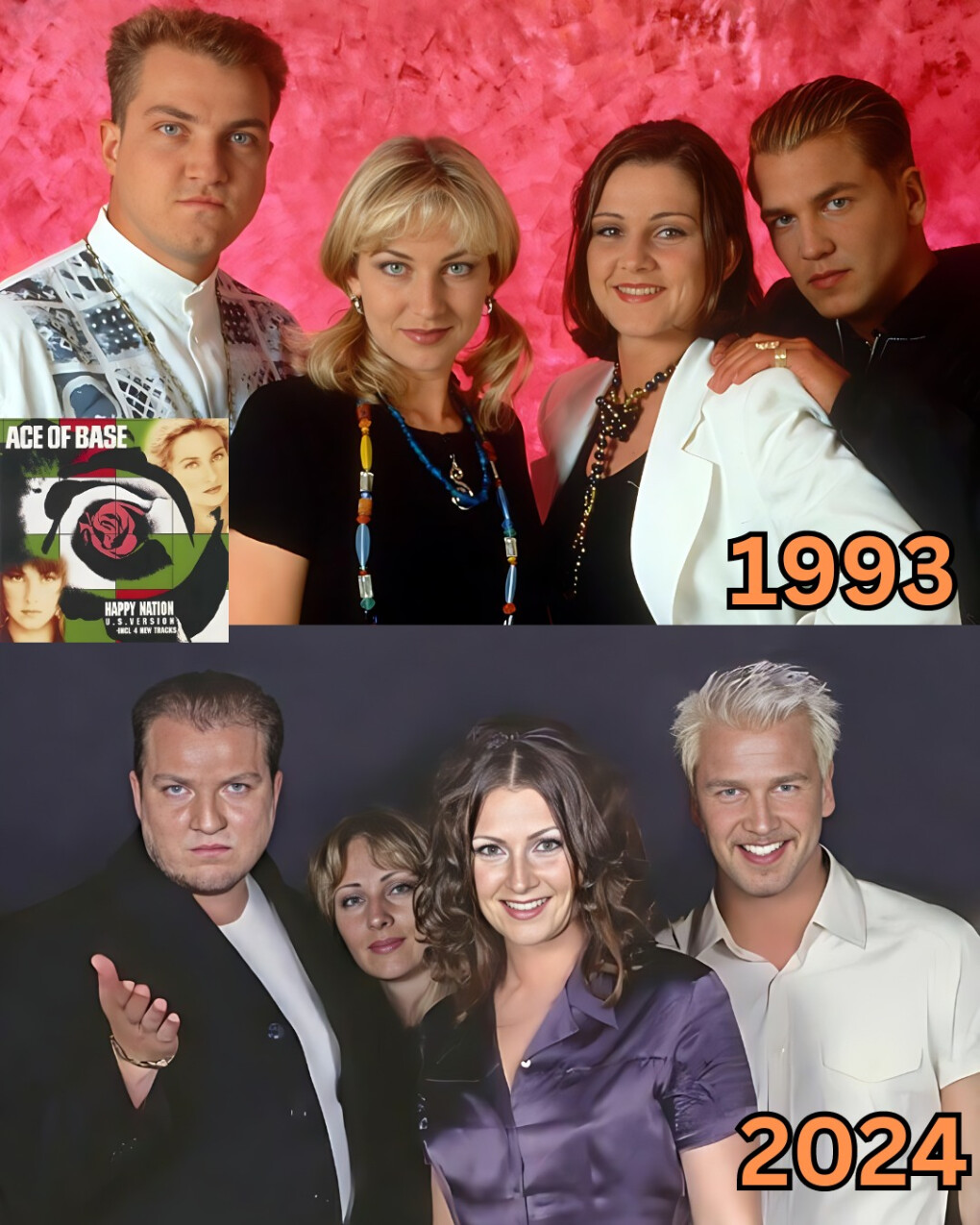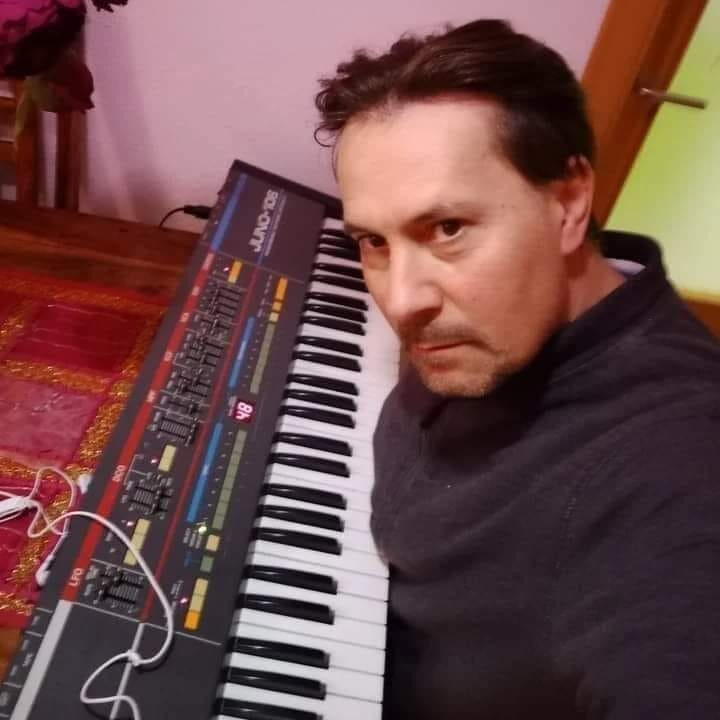Synthés dans la techno dans les années 90.
- 102 réponses
- 19 participants
- 9 781 vues
- 30 followers
minimalteck
694
Posteur·euse AFfolé·e
Membre depuis 16 ans
Sujet de la discussion Posté le 09/01/2023 à 23:13:46Synthés dans la techno dans les années 90.
Pour faire suite/parrallèle aux excellents Synthés dans la variété internationale dans les années 80 et Synthés dans la variété française 80s ? et surtout ne pas les polluer, j'ouvre donc un nouveau !
Je vous invite à partager sans limite toutes vos connaissances sur le sujet, on en apprend jamais assez
Connu et vu déjà sur AF, mais je me concentre sur le matos :
Simon Posford Interview in the Studio // Hallucinogen, mais pas d'époque certainement plus récent...
Korg MS-20, Oscar, Roland SH-5, le Yamaha VSS-200 modifié , une table Mackie 32-8bus (je n'ai pas réussi à identifier le synthé à gauche de la table, peut-être un Roland V-Synth ?)
, une table Mackie 32-8bus (je n'ai pas réussi à identifier le synthé à gauche de la table, peut-être un Roland V-Synth ?)
les modules : Apogee Big Ben, Apogee Rosetta 800-192k, alesis quadraverb, Empirical Labs Distressor EL8, Eventide DSP 4000, Eventide Orville, Drawmer S3...
Par contre je sèche sur les racks sous les Distressor... notamment l'égaliseur ? en 2U...
De l'époque Transwave TBE 1996, juste énorme !!!
Roland SH-101, Juno 106, JD-800, Atari 1040 ST ? p'tete un JV-80 devant le Juno, pour le reste... je vois pas trop...
... évidemment à l'image, et hors sujet, des platines Technics SL1200 mk2 et une jolie Freevox (club 6 ?)
D'autres à venir certainement, mais difficile de trouver des vidéos (de qualité) sur le Web où l'on peut identifier des machines...
Quant aux autres infos, je semble être un mauvais pêcheur... je ne trouve rien à nous mettre sous la dent...
Allez à vous les fondus de synthés et de musique électronique !!!
Je vous invite à partager sans limite toutes vos connaissances sur le sujet, on en apprend jamais assez
Connu et vu déjà sur AF, mais je me concentre sur le matos :
Simon Posford Interview in the Studio // Hallucinogen, mais pas d'époque certainement plus récent...
Korg MS-20, Oscar, Roland SH-5, le Yamaha VSS-200 modifié
les modules : Apogee Big Ben, Apogee Rosetta 800-192k, alesis quadraverb, Empirical Labs Distressor EL8, Eventide DSP 4000, Eventide Orville, Drawmer S3...
Par contre je sèche sur les racks sous les Distressor... notamment l'égaliseur ? en 2U...
De l'époque Transwave TBE 1996, juste énorme !!!
Roland SH-101, Juno 106, JD-800, Atari 1040 ST ? p'tete un JV-80 devant le Juno, pour le reste... je vois pas trop...
... évidemment à l'image, et hors sujet, des platines Technics SL1200 mk2 et une jolie Freevox (club 6 ?)
D'autres à venir certainement, mais difficile de trouver des vidéos (de qualité) sur le Web où l'on peut identifier des machines...
Quant aux autres infos, je semble être un mauvais pêcheur... je ne trouve rien à nous mettre sous la dent...
Allez à vous les fondus de synthés et de musique électronique !!!
kosmix
51266
AF, je suis ton père
Membre depuis 19 ans
81 Posté le 11/04/2024 à 15:52:39
En matière d'électro moi j'y reviens toujours car je ne m'en lasse pas.
0
Putain Walter mais qu'est-ce que le Vietnam vient foutre là-dedans ?
vilak
4046
Squatteur·euse d’AF
Membre depuis 8 ans
82 Posté le 25/04/2024 à 21:30:43
Vince Clarke home studio, juillet 1994.
There can't be many recording studios in the world built to resemble a landed spaceship. The studio building took two years to design and a further two to build, so complex was its construction. Before anything else was done, the contractors had to excavate half a sphere in the ground, blow up a massive circular balloon in the hole, and plaster the top with girders and concrete to achieve the unusual dome shape.
The top half of the dome houses the control room itself, together with a small lobby-cum-kitchen; stairs lead down from this to a plush vocal booth and an underground storeroom of vintage electronica. Keyboards, synths, amps, and all manner of devices line the walls in here. Unfortunately, because the watertable is so high in this part of the world, the basement is at risk from flooding - so the studio has an automatic flood alarm built in!
Back upstairs, the control-room roof has an enormous central skylight, lined with an impressive array of acoustic panels. Spotlights ring a central, raised plinth, which houses the customised mixing desk and effects rack, together with a workbench for the Roland and BBC sequencers. The outer walls of the room are lined with racks and racks of analogue synthesisers, all of which can be linked into a central patching system.
"All the outside patch lines are parallel, so I can use an LFO from that synth to modulate this one over here," explains Vince. "It's the same sort of vibe as I had in Amsterdam. All of these tielines go into a central patchbay. You need that to stop the cables trailing everywhere.
"All that steel stuff in the roof is for the sound. A guy called Sean Davis did all the acoustics, and made the monitors and the amps as well. Go Digital were the company responsible for the whole thing, and Exclusively Analogue take care of the synths. We're still working on it, to be honest, but it's nearly there. The desk is much simpler than the one I had in Amsterdam - it's a broadcasting desk, which means it only has bass and treble controls. All the modules are arranged in a circle.
"I've got an old Studer analogue halfinch mastering machine now; it used to be a quarter-inch, but I had a bigger head put on. You can't beat the sound of that. It's the same with the A80 24-track machine - I love it. And all the monitoring is powered by valve amps. The room sounds fantastic now.
The only real additions since Amsterdam are a couple of effects boxes, the six-channel analogue sequencer and a Buchla modular synth, which I think I used for one sound on the album! I want to try and get more of the stuff in storage downstairs up here as well.
"It's really nice to work in here; really pleasant. It's great having all my gear in one place and in this formation."


There can't be many recording studios in the world built to resemble a landed spaceship. The studio building took two years to design and a further two to build, so complex was its construction. Before anything else was done, the contractors had to excavate half a sphere in the ground, blow up a massive circular balloon in the hole, and plaster the top with girders and concrete to achieve the unusual dome shape.
The top half of the dome houses the control room itself, together with a small lobby-cum-kitchen; stairs lead down from this to a plush vocal booth and an underground storeroom of vintage electronica. Keyboards, synths, amps, and all manner of devices line the walls in here. Unfortunately, because the watertable is so high in this part of the world, the basement is at risk from flooding - so the studio has an automatic flood alarm built in!
Back upstairs, the control-room roof has an enormous central skylight, lined with an impressive array of acoustic panels. Spotlights ring a central, raised plinth, which houses the customised mixing desk and effects rack, together with a workbench for the Roland and BBC sequencers. The outer walls of the room are lined with racks and racks of analogue synthesisers, all of which can be linked into a central patching system.
"All the outside patch lines are parallel, so I can use an LFO from that synth to modulate this one over here," explains Vince. "It's the same sort of vibe as I had in Amsterdam. All of these tielines go into a central patchbay. You need that to stop the cables trailing everywhere.
"All that steel stuff in the roof is for the sound. A guy called Sean Davis did all the acoustics, and made the monitors and the amps as well. Go Digital were the company responsible for the whole thing, and Exclusively Analogue take care of the synths. We're still working on it, to be honest, but it's nearly there. The desk is much simpler than the one I had in Amsterdam - it's a broadcasting desk, which means it only has bass and treble controls. All the modules are arranged in a circle.
"I've got an old Studer analogue halfinch mastering machine now; it used to be a quarter-inch, but I had a bigger head put on. You can't beat the sound of that. It's the same with the A80 24-track machine - I love it. And all the monitoring is powered by valve amps. The room sounds fantastic now.
The only real additions since Amsterdam are a couple of effects boxes, the six-channel analogue sequencer and a Buchla modular synth, which I think I used for one sound on the album! I want to try and get more of the stuff in storage downstairs up here as well.
"It's really nice to work in here; really pleasant. It's great having all my gear in one place and in this formation."


1
kosmix
51266
AF, je suis ton père
Membre depuis 19 ans
83 Posté le 25/04/2024 à 23:03:45
Il était bien sous son dôme avec son matos.
1
Putain Walter mais qu'est-ce que le Vietnam vient foutre là-dedans ?
vilak
4046
Squatteur·euse d’AF
Membre depuis 8 ans
84 Posté le 26/04/2024 à 12:25:30
Ah ben je crois qu'aucun d'entre nous ne déprimerait à sa place!
0
vilak
4046
Squatteur·euse d’AF
Membre depuis 8 ans
85 Posté le 14/05/2024 à 16:17:38

ACE OF BASE, "THE SIGN" :
The track starts out with four bars of a dance beat made with a kick drum, hand clap, and snare, struck so closely together that the ear hears them as one sound; this would become Cheiron’s sonic signature. The sound incorporates fragments of a sample from “Shack Up,” a song by Banbarra, a U.S. funk group from the ’70s. A synthetic log drum plays on the off beats, making a woody, thwoka thwoka sound. Mixed in with the electronically made music is a track of Carr playing timbales and cymbals, to lighten the robotic feel. Then comes the first melodic hook, a wheedling synth flute made with an EMU vintage module that is out of phase—a mistake that sounded cool so they left it. Underneath the flute is the bass, which is actually two sounds mixed together: a Moog sub-bass and a Korg M1 bass on top. “The bass took some figuring out,” Carr says. “I remember us talking a lot about the space that the reggae bass players always make in their music, and how important that is—that sense of air.”
Then the singing starts. A reggae rhythm guitar sound made on a Yamaha TG77 synthesizer plays a Nile Rodgers guitar riff. A dry tap of a snare, and then comes the hook.
0
vilak
4046
Squatteur·euse d’AF
Membre depuis 8 ans
86 Posté le 25/05/2024 à 18:15:41
x
Hors sujet :0
vilak
4046
Squatteur·euse d’AF
Membre depuis 8 ans
87 Posté le 30/05/2024 à 16:05:14
vilak
4046
Squatteur·euse d’AF
Membre depuis 8 ans
88 Posté le 18/06/2024 à 12:21:47
Trouvé sur Facebook (traduction française à l'origine en espagnol) :
J'imagine que mon histoire est celle de beaucoup d'autres musiciens frustrés de ne pas avoir eu de chance dans cette grande aventure qu'est la musique, ont abandonné leur illusion de créer de la musique et se sont résignés.
À la fin des années 90, je faisais partie d'un groupe Synthpop à Madrid, presque tous les après-midi, nous préparions les chansons avec beaucoup d'illusion, finalement nous avons pu concrétiser notre rêve et nous sommes allés enregistrer 5 chansons dans un studio de la rue Gênes appartenant à un ami. Je me souviens quand ils nous ont donné le Master de la chanson.
Je me souviens avoir utilisé un Prophet VS, Juno 106, Roland D-50, D-110 et TR-909.
Je pense que nous avons acheté environ 50 cassettes, fait les copies et imprimé une lettre de motivation, nous avons envoyé les colis à des producteurs espagnols. Je me souviens de ce moment avec beaucoup d'illusion.
Sans surprise, l'attente a été longue et personne ne nous a contacté, résigné j'ai abandonné la musique apparemment pour toujours.
Les réseaux sociaux que certains musiciens critiquent tant m'ont donné l'opportunité comme d'autres musiciens amateurs de montrer mon travail au monde et de laisser les gens juger la musique et non pas certains producteurs
Il est très important pour moi de vous montrer mon premier album Plenilune, fait avec illusion, passion et beaucoup de travail, mais surtout en sachant saisir cette seconde chance que la vie me donnait.
Un jour j'enregistrerai la chanson Larmes de sable pour que vous puissiez voir à quel point nous étions bons dans les années 90.
Rafael Sáez - Plénilune :
01. Étoiles
https://on.soundcloud.com/8wmGN
02. Envole-toi vers ton rêve
https://on.soundcloud.com/29Jjj
03. Pluie
https://soundcloud.com/wavesproject/rain
04. Tu me veux (Cyborgdrive Remix)
https://on.soundcloud.com/HYw7S
05. Rêves tombés (Cyborgdrive Remix)
https://on.soundcloud.com/dG8on
06. Ensemble
https://on.soundcloud.com/hR4dY
07. Tu me veux
https://on.soundcloud.com/vQZRF
08. Marche seul
https://on.soundcloud.com/UvTML
09. Ensemble (McV Remix)
https://on.soundcloud.com/NFVzS
@fans destacados
Sáez - Plénilune 2024
Ps : j'ai informé l'auteur de ma publication, ce serait gentil de lui donner votre feedback!

J'imagine que mon histoire est celle de beaucoup d'autres musiciens frustrés de ne pas avoir eu de chance dans cette grande aventure qu'est la musique, ont abandonné leur illusion de créer de la musique et se sont résignés.
À la fin des années 90, je faisais partie d'un groupe Synthpop à Madrid, presque tous les après-midi, nous préparions les chansons avec beaucoup d'illusion, finalement nous avons pu concrétiser notre rêve et nous sommes allés enregistrer 5 chansons dans un studio de la rue Gênes appartenant à un ami. Je me souviens quand ils nous ont donné le Master de la chanson.
Je me souviens avoir utilisé un Prophet VS, Juno 106, Roland D-50, D-110 et TR-909.
Je pense que nous avons acheté environ 50 cassettes, fait les copies et imprimé une lettre de motivation, nous avons envoyé les colis à des producteurs espagnols. Je me souviens de ce moment avec beaucoup d'illusion.
Sans surprise, l'attente a été longue et personne ne nous a contacté, résigné j'ai abandonné la musique apparemment pour toujours.
Les réseaux sociaux que certains musiciens critiquent tant m'ont donné l'opportunité comme d'autres musiciens amateurs de montrer mon travail au monde et de laisser les gens juger la musique et non pas certains producteurs
Il est très important pour moi de vous montrer mon premier album Plenilune, fait avec illusion, passion et beaucoup de travail, mais surtout en sachant saisir cette seconde chance que la vie me donnait.
Un jour j'enregistrerai la chanson Larmes de sable pour que vous puissiez voir à quel point nous étions bons dans les années 90.
Rafael Sáez - Plénilune :
01. Étoiles
https://on.soundcloud.com/8wmGN
02. Envole-toi vers ton rêve
https://on.soundcloud.com/29Jjj
03. Pluie
https://soundcloud.com/wavesproject/rain
04. Tu me veux (Cyborgdrive Remix)
https://on.soundcloud.com/HYw7S
05. Rêves tombés (Cyborgdrive Remix)
https://on.soundcloud.com/dG8on
06. Ensemble
https://on.soundcloud.com/hR4dY
07. Tu me veux
https://on.soundcloud.com/vQZRF
08. Marche seul
https://on.soundcloud.com/UvTML
09. Ensemble (McV Remix)
https://on.soundcloud.com/NFVzS
@fans destacados
Sáez - Plénilune 2024
Ps : j'ai informé l'auteur de ma publication, ce serait gentil de lui donner votre feedback!

1
vilak
4046
Squatteur·euse d’AF
Membre depuis 8 ans
89 Posté le 01/07/2024 à 18:09:08
Décidément...
1
vilak
4046
Squatteur·euse d’AF
Membre depuis 8 ans
90 Posté le 04/08/2024 à 14:51:23
- < Liste des sujets
- Charte



